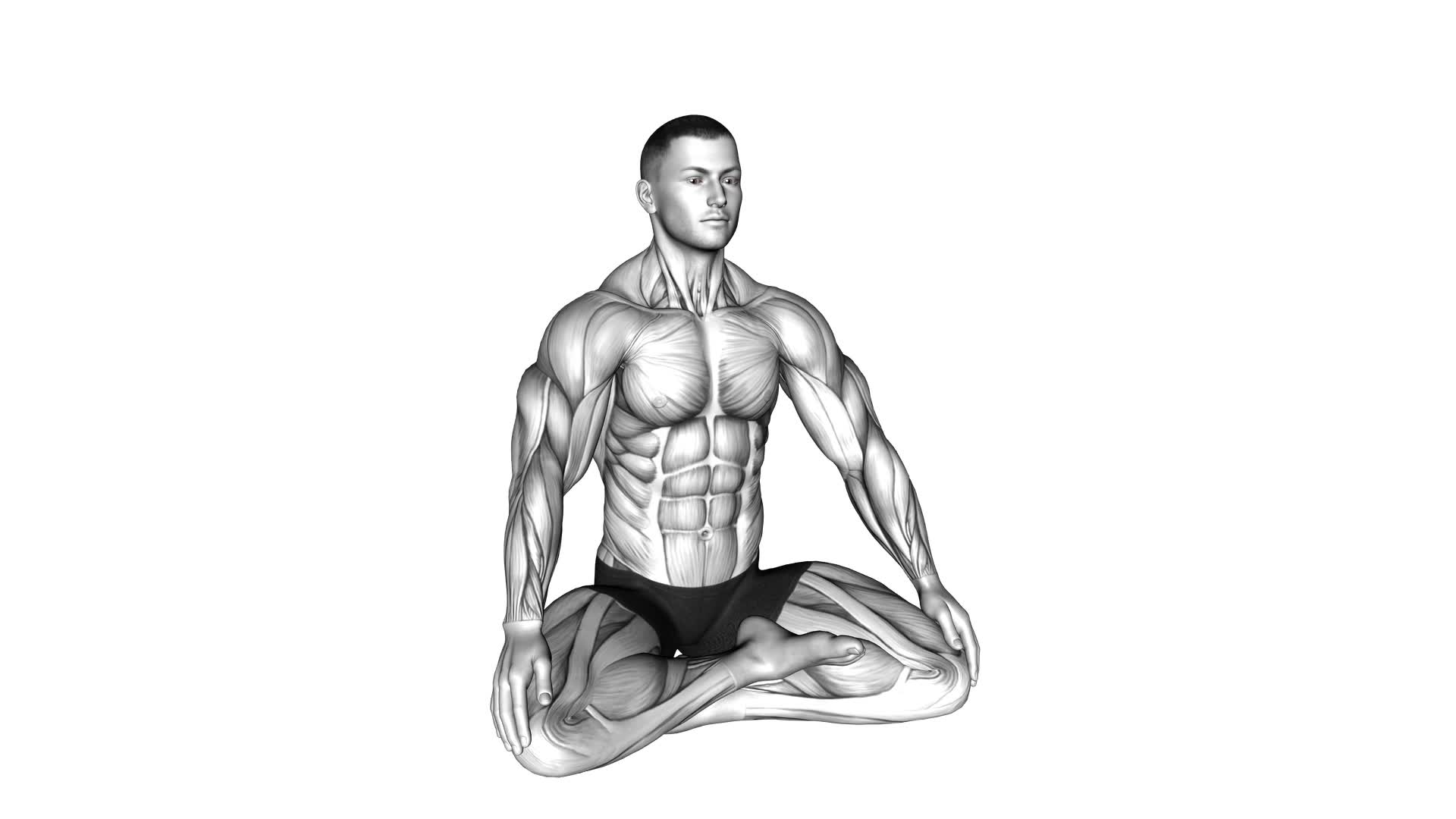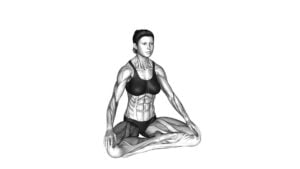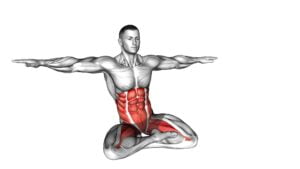Lotus Pose Breathing (male) – Video Exercise Guide & Tips

Get ready to elevate your yoga practice with Lotus Pose Breathing!
Watch This Exercise Video
In this video exercise guide, you'll discover the incredible benefits this pose offers men.
From increasing flexibility to calming the mind, Lotus Pose Breathing has it all.
You'll also learn how to prepare for the pose, maintain proper alignment, and avoid common mistakes.
With our step-by-step instructions and helpful tips, you'll be able to deepen your practice and experience the full potential of Lotus Pose Breathing.
Let's get started!
Key Takeaways
- Lotus Pose Breathing improves prostate health and urinary function for men.
- Preparing for Lotus Pose Breathing involves warm-up exercises and hip-opening poses.
- Proper alignment in Lotus Pose Breathing focuses on spinal alignment and engaging the core muscles.
- Maintaining proper posture in Lotus Pose Breathing promotes relaxation, reduces stress, and increases oxygen intake.
Benefits of Lotus Pose Breathing for Men
If you practice lotus pose breathing regularly, you can experience numerous benefits for your overall well-being as a man. Lotus pose breathing, also known as Padmasana Pranayama, has specific benefits that cater to the male body and mind.
One of the key benefits is its ability to improve prostate health. By practicing lotus pose breathing, you can enhance blood flow to the pelvic region, which can help reduce the risk of prostate issues and improve urinary function.
Additionally, lotus pose breathing can also help improve focus and concentration. As a man, you may often face various challenges and responsibilities that require mental clarity and focus. By incorporating lotus pose breathing into your routine, you can enhance your cognitive abilities and better navigate through these demands.
To further enhance the benefits of lotus pose breathing for men, there are some modifications that you can make. If sitting in the traditional lotus position is uncomfortable, you can opt for a half lotus or easy cross-legged position. This modification allows you to still enjoy the benefits of lotus pose breathing without straining your hips or knees.
In conclusion, lotus pose breathing offers specific benefits for men, including improved prostate health and enhanced focus and concentration. By making modifications to suit your body's comfort, you can maximize the advantages of this practice.
Now that we've explored the benefits, let's move on to the next section about preparing for lotus pose breathing.
Preparing for Lotus Pose Breathing
To prepare for lotus pose breathing, focus on aligning your body and creating a comfortable space for practice. Here are some preparation techniques and lotus pose modifications to help you get started:
- Warm-up exercises: Begin with gentle stretches and movements to warm up your body. This will help loosen tight muscles and improve flexibility, making it easier to get into lotus pose.
- Hip openers: Lotus pose requires deep hip flexibility. Incorporate hip-opening poses like pigeon pose or butterfly pose into your warm-up routine to prepare your hips for the lotus position.
- Use props: If you find it challenging to sit comfortably in lotus pose, try using props such as blankets or blocks. Placing a folded blanket under your hips can provide extra support and elevate your pelvis, making it easier to maintain the posture.
Proper Alignment in Lotus Pose Breathing
To achieve proper alignment in Lotus Pose Breathing, it's crucial to focus on spinal alignment and maintaining good posture.
Your spine should be straight and elongated, with your shoulders relaxed and pulled back.
This alignment ensures optimal breath flow and allows for a more effective and comfortable practice.
Spinal Alignment During Lotus
Maintain proper spinal alignment in Lotus Pose by engaging your core and lengthening your spine. This won't only help you achieve a more comfortable and stable posture, but it will also prevent any strain or injury to your back. Here are three important tips to ensure proper spinal alignment during Lotus Pose:
- Relax your hips: Before coming into Lotus Pose, make sure your hips are relaxed and open. This will allow for a greater range of motion and decrease the chances of putting unnecessary pressure on your spine.
- Lengthen your spine: Imagine a string pulling the top of your head towards the ceiling. Lengthening your spine will help create space between each vertebra and promote a healthier posture.
- Engage your core: Activating your abdominal muscles will provide stability and support to your spine. By engaging your core, you can maintain proper alignment throughout your practice and avoid any rounding or collapsing of the spine.
Importance of Proper Posture
Having proper posture is crucial for maintaining proper alignment in Lotus Pose Breathing. Proper posture allows you to fully engage your core muscles, ensuring that your spine is aligned and supported throughout the practice. This alignment not only helps prevent strain and injury, but it also allows for a more effective and efficient flow of energy throughout your body.
When practicing Lotus Pose Breathing, proper alignment is particularly important because it's a form of meditation that focuses on deep breathing. Maintaining good posture helps to open up your chest and lungs, allowing for deeper and more expansive breaths. This deep breathing promotes relaxation, reduces stress, and increases oxygen intake, which can have numerous benefits for your physical and mental well-being.
Now that you understand the importance of proper posture in Lotus Pose Breathing, let's dive into a step-by-step guide to help you achieve the correct alignment and fully enjoy the practice.
Step-by-Step Guide to Lotus Pose Breathing
Sit comfortably on the floor with your legs crossed in a lotus position. Lotus Pose breathing is a powerful technique that can help calm the mind, reduce stress, and increase focus. Here is a step-by-step guide to help you practice this technique effectively:
- Find a quiet and peaceful space: Choose a calm environment where you can sit undisturbed for a few minutes. This will allow you to fully focus on your breathing and experience the benefits of Lotus Pose breathing.
- Assume the Lotus Pose: Begin by sitting on the floor with your legs crossed. If the full Lotus Pose is challenging, you can modify it by placing one foot on the opposite thigh or sitting on a cushion for added support.
- Focus on your breath: Close your eyes and take a few deep breaths to relax your body and mind. Once you feel centered, shift your attention to your breath. Slowly inhale through your nose, filling your lungs with air, and exhale through your mouth, releasing any tension or stress.
Common Mistakes to Avoid in Lotus Pose Breathing
To ensure proper breath control in Lotus Pose, it's important to focus on deep belly breathing and avoid shallow chest breathing. This will help you relax and find a sense of calm during the practice.
Additionally, be mindful of your knee placement to avoid strain or injury. Keep your knees relaxed and gently press them down towards the ground without forcing them.
Proper Breath Control
To achieve proper breath control in Lotus Pose, you need to focus on maintaining a relaxed and steady breath rhythm. This is essential for maximizing the benefits of the pose and promoting a sense of calm and mindfulness.
Here are three key points to keep in mind:
- Deep Breathing: Take slow, deep breaths, filling your lungs completely. This helps to oxygenate your body and relax your muscles, allowing you to sink deeper into the pose.
- Smooth Exhalation: Pay attention to your exhale, ensuring it's smooth and controlled. This helps to release tension and promote a sense of relaxation throughout your body.
- Mindful Awareness: Stay present and focused on your breath throughout the practice. This mindfulness training enhances your overall yoga experience and helps to deepen the mind-body connection.
Avoiding Knee Strain
To avoid knee strain in Lotus Pose Breathing, focus on maintaining proper alignment and engaging your core muscles. This will help you avoid knee injuries and ensure a safe practice.
When practicing Lotus Pose, it's important to modify the pose if you experience any discomfort or strain in your knees. One common mistake to avoid is forcing your knees into a full lotus position if your hips or knees aren't ready for it. Instead, you can start with a half lotus pose or use props like blankets or blocks to support your knees.
Another important tip is to listen to your body and only go as far as feels comfortable for you. Remember, the goal is to create a safe and sustainable practice that benefits your overall well-being.
Tips to Deepen Your Lotus Pose Breathing Practice
Deepen your Lotus Pose breathing practice by focusing on the expansion of your diaphragm. By incorporating these tips, you can enhance your breath awareness and deepen your focus during your practice:
- Relax your body: Before you begin your Lotus Pose breathing, take a moment to relax your body. Sit in a comfortable position and gently close your eyes. Focus on releasing any tension or stress in your muscles, allowing your body to fully relax. This will create a solid foundation for your breath work.
- Engage your diaphragm: As you inhale, consciously expand your diaphragm. Imagine your breath flowing deep into your belly, filling your lungs completely. This will help you deepen your breath and increase your lung capacity.
- Maintain a steady rhythm: Establish a steady and consistent rhythm of inhaling and exhaling. This will help you stay focused and present in the moment. As you breathe, try to create a smooth and flowing pattern, allowing your breath to guide your movement.
Frequently Asked Questions
Can Women Also Practice Lotus Pose Breathing?
Yes, women can definitely practice lotus pose breathing. It isn't gender-specific and can be beneficial for women's physical health as well.
This practice helps to increase flexibility, improve posture, and calm the mind.
If you're a beginner, there are modifications you can make to make it more accessible. Start with a half lotus or cross-legged position and gradually work towards the full lotus.
Remember to listen to your body and take it at your own pace.
How Long Should I Hold Lotus Pose Breathing?
To improve flexibility for lotus pose breathing, it's important to practice regularly and gradually increase the duration of your holds.
Start by holding the pose for a few breaths and gradually work your way up to longer durations.
Remember to listen to your body and not push yourself too hard.
If you're finding it difficult to hold the full lotus pose, you can try variations or modifications such as half lotus or using props for support.
Can Lotus Pose Breathing Help With Anxiety and Stress?
Lotus pose breathing is a great practice for beginners looking to reduce anxiety and stress. By focusing on your breath and the gentle movements of the pose, you can calm your mind and bring a sense of peace to your body.
There are different variations of lotus pose breathing that you can explore to find what works best for you. Incorporating this practice into your routine can bring numerous benefits for your mental and emotional well-being.
What Are the Benefits of Practicing Lotus Pose Breathing Regularly?
Regularly practicing lotus pose breathing can have numerous benefits for your mental well-being. It can help enhance mental clarity by promoting relaxation and reducing stress levels.
This deep breathing technique allows you to focus on your breath, bringing your attention to the present moment and improving your overall focus.
Are There Any Precautions or Contraindications for Practicing Lotus Pose Breathing?
When practicing lotus pose breathing, it's important to be aware of any precautions or contraindications that may apply to you. Certain conditions like knee or ankle injuries, hip problems, or lower back pain may make it difficult or uncomfortable to perform this pose.
Additionally, if you're pregnant or have high blood pressure, it's recommended to avoid this breathing exercise.
Always consult with a qualified instructor or healthcare professional before attempting any new exercise.
Conclusion
In conclusion, Lotus Pose Breathing is a beneficial practice for men, offering various advantages such as improved focus, reduced stress, and enhanced flexibility.
By following proper alignment and using the step-by-step guide, men can effectively engage in this breathing exercise.
It's important to avoid common mistakes and gradually deepen the practice over time.
With regular practice and dedication, men can experience the full benefits of Lotus Pose Breathing.

Author
Years ago, the spark of my life’s passion ignited in my mind the moment I stepped into the local gym for the first time. The inaugural bead of perspiration, the initial endeavor, the very first surge of endorphins, and a sense of pride that washed over me post-workout marked the beginning of my deep-seated interest in strength sports, fitness, and sports nutrition. This very curiosity blossomed rapidly into a profound fascination, propelling me to earn a Master’s degree in Physical Education from the Academy of Physical Education in Krakow, followed by a Sports Manager diploma from the Jagiellonian University. My journey of growth led me to gain more specialized qualifications, such as being a certified personal trainer with a focus on sports dietetics, a lifeguard, and an instructor for wellness and corrective gymnastics. Theoretical knowledge paired seamlessly with practical experience, reinforcing my belief that the transformation of individuals under my guidance was also a reflection of my personal growth. This belief holds true even today. Each day, I strive to push the boundaries and explore new realms. These realms gently elevate me to greater heights. The unique combination of passion for my field and the continuous quest for growth fuels my drive to break new ground.







